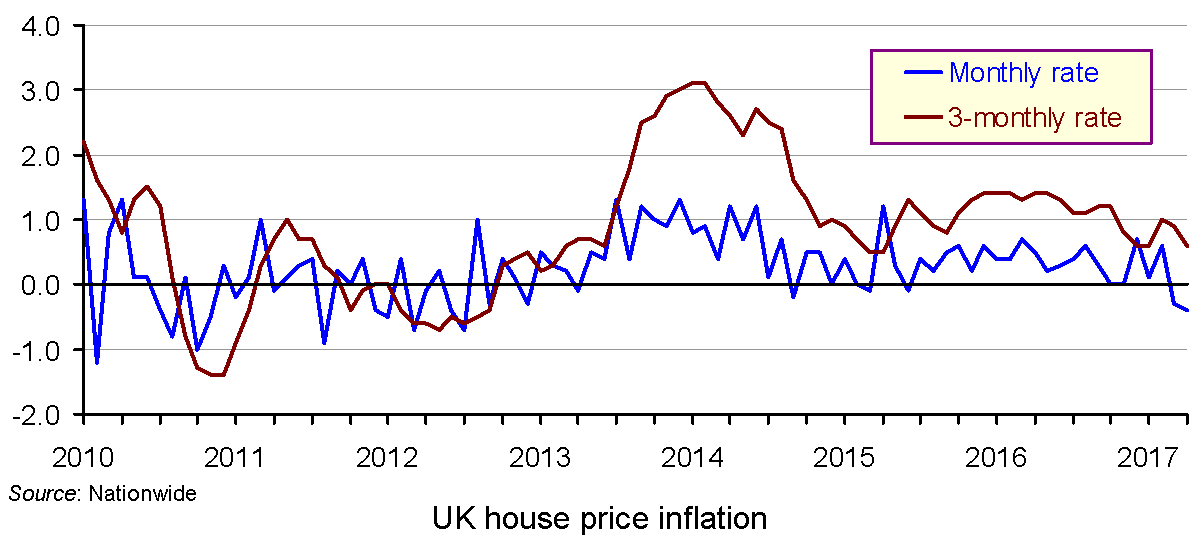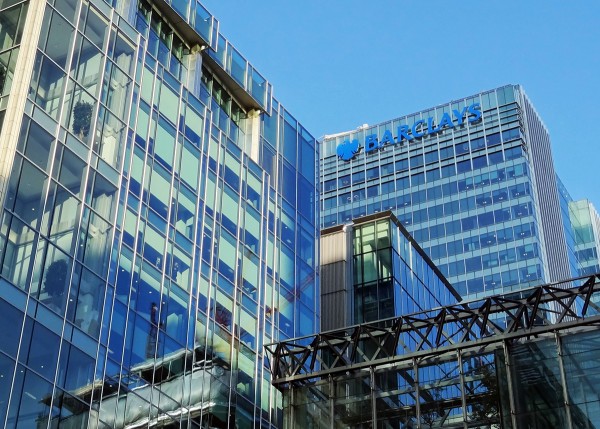 According to the Halifax house price index, house prices fell in the UK in the three months to April. This is the first quarterly fall since 2012. The Nationwide index (see below), shows that prices in April were 0.4% lower than in March (although the 3-month rate was still slightly positive).
According to the Halifax house price index, house prices fell in the UK in the three months to April. This is the first quarterly fall since 2012. The Nationwide index (see below), shows that prices in April were 0.4% lower than in March (although the 3-month rate was still slightly positive).
The fall in house prices reflects a cooling in demand. This, in turn, reflects a squeeze on household incomes as price rises begin to overtake wage rises. It also reflects buyers becoming more cautious given the uncertainty over the nature of the Brexit deal and its effects on the economy and people’s incomes.
The fall in demand is also driven by recent Bank of England rules which require mortgage lenders to limit the proportion of mortgages with a mortgage/income ratio of 4.5 or above to no more than 15% of their new mortgages. It is also affected by a rise in stamp duty, especially on buy-to-let properties.
Despite the fall in prices, this may understate the fall in demand relative to supply. House price movements often lag behind changes in demand and supply as people are reluctant to adjust to equilibrium prices. In the case of a falling market, sellers may be unwilling to sell at the lower equilibrium price, believing that a lower price ‘undervalues’ their property. Indeed, they may not even put their houses on the market. This makes prices ‘sticky’ downwards. The result is a fall in sales.

Eventually, such people will reluctantly be prepared to accept a lower price and prices will thus fall more. Once people come to expect price falls, supply may increase further as vendors seek to sell before the price falls even more. So we could well see further falls over the coming months.
 Lower house prices and falling sales is a picture repeated in many parts of the UK. It is particularly marked in central London. There, estate agents have begun to offer free gifts to purchasers. As The Guardian puts it:
Lower house prices and falling sales is a picture repeated in many parts of the UK. It is particularly marked in central London. There, estate agents have begun to offer free gifts to purchasers. As The Guardian puts it:
London estate agents have begun to offer free cars worth £18,000, stamp duty subsidies of £150,000, plus free iPads and Sonos sound systems to kickstart sales in the capital’s increasingly moribund property market. The once super-hot central London market has turned into a ‘burnt-out core’ according to buying agents Garrington Property Finders, prompting developers to offer ever greater incentives to lure buyers.
… Land Registry figures show that in the heart of the city’s financial district, average property prices plummeted from £861,000 at the time of the EU referendum to £773,000 in February, a decline of 15%, although in London’s outer boroughs prices are still up over the year.
But lower property prices are good news for first-time buyers, although some of the biggest falls have been in the top end of the market.
The fall in property prices may continue for a few months. But population is rising, and with it the number of people who would like to buy their own home. Once real incomes begin to rise again, therefore, demand is likely to resume rising faster than supply. When it does, house prices will continue their upward trend.
Articles
UK house prices in first quarterly fall since 2012 BBC News (8/5/17)
UK house prices fall again in April as buyers feel the pinch The Guardian, Angela Monaghan (28/4/17)
Buy a home, get a car free: offers galore as London estate agents struggle to sell The Guardian, Patrick Collinson (3/5/17)
London is now one of the five cities with the lowest house price growth in the UK City A.M., Helen Cahill (28/4/17)
London Housing Market Property Bubble Vulnerable To Crash The Market Oracle, Jan Skoyles (3/5/17)
A key indicator of a healthy housing market is flashing red in London Business Insider, Thomas Colson (29/5/17)
House Price Data
UK House Prices – links to various sites Economic Data freely available online – Economics Network
Questions
- Why are UK house prices falling?
- What determines the rate at which they are falling? How is the price elasticity of demand and/or supply relevant here?
- How does speculation help to explain changes in house prices? How may speculation help to (a) stabilise and (b) destabilise house prices?
- Draw a demand and supply diagram to show how house transactions will be lower if the market is not in equailibrium.
- Why are house prices falling faster in central London than elsewhere in the UK?
- Why are rents falling in central London? How does this relate to the fall in central London property prices?
- How has the Help to Buy scheme affected house prices? Has it affected both demand and supply and, if so, why and how?
- How do changes in residential property transaction volumes relate to changes in property prices?
- What market imperfections exist in the housing market?
 Interest rates have been at record lows across the developed world since 2009. Interest rates were reduced to such levels in order to stimulate recovery from the financial crisis of 2007–8 and the resulting recession. The low interest rates were accompanied by extraordinary increases in money supply under various rounds of quantitative easing in the USA, UK, Japan and eventually the eurozone. But have such policies done harm?
Interest rates have been at record lows across the developed world since 2009. Interest rates were reduced to such levels in order to stimulate recovery from the financial crisis of 2007–8 and the resulting recession. The low interest rates were accompanied by extraordinary increases in money supply under various rounds of quantitative easing in the USA, UK, Japan and eventually the eurozone. But have such policies done harm?
This is the contention of Brian Sturgess in a new paper, published by the Centre for Policy Studies. He maintains that the policy has had a number of adverse effects:
|
|
| • |
There will be nothing left in the monetary policy armoury when the next downturn occurs other than even more QE, which will compound the following problems. |
| • |
It has had little effect in stimulating aggregate demand and economic growth. Instead the extra money has been used to repair balance sheets and support unprofitable businesses. |
| • |
It has inflated asset prices, especially shares and property, which has encouraged funds to flow to the secondary market rather than to funding new investment. |
| • |
The inflation of asset prices has benefited the already wealthy. |
| • |
By keeping interest rates down to virtually zero on savings accounts, it has punished small savers. |
| • |
By rewarding the rich and penalising small savers, it has contributed to greater inequality. |
| • |
By keeping interest rates down to borrowers, it has encouraged households to take on excessive amounts of debt, which will be hard to service if interest rates rise. |
| • |
It has lowered the price of risk, thereby encouraging more risky types of investment and the general misallocation of capital. |
 Sturgess argues that it is time to end the policy of low interest rates. Currently, in all the major developed economies, central bank rates are below the rate of inflation, making the real central bank interest rates negative.
Sturgess argues that it is time to end the policy of low interest rates. Currently, in all the major developed economies, central bank rates are below the rate of inflation, making the real central bank interest rates negative.
He welcomes the two small increases by the Federal Reserve, but this should be followed by further rises, not just by the Fed, but by other central banks too. As Sturgess states in the paper (p.12):
In place of ever more extreme descents into the unknown, central banks should quickly renormalise monetary policy. That would involve ending QE and allowing interest rates to rise steadily so that interest rates can carry out their proper functions. Failure to do so will leave the global financial system vulnerable to potential shocks such as the failure of the euro, or the fiscal stresses in the US resulting from the unfinanced spending plans announced by Donald Trump in his presidential campaign.
Although Sturgess argues that the initial programmes of low interest rates and QE were a useful response to the financial crisis, he argues that they should have only been used as a short-term measure. However, if they were, and if interest rates had gone up within a few months, many argue that the global economy would rapidly have sunk back into recession. This has certainly been the position of central banks. Sturgess disagrees.
Articles
Damaging low interest rates and QE must end now, think thank warns The Telegraph, Julia Bradshaw (23/1/17)
QE has driven pension deficits up, think-tank argues Money Marketing, Justin Cash (23/1/17)
Hold: The ECB keeps interest rates and QE purchases steady as Mario Draghi defends loose policy from hawkish critics City A.M., Jasper Jolly (19/1/17)
Preparing for the Post-QE World Bloomberg, Jean-Michel Paul (12/10/16)
Paper
Stop Depending on the Kindness of Strangers: Low interest rates and the Global Economy Centre for Policy Studies, Brian Sturgess (23/1/17)
Questions
- Find out what the various rounds of quantitative easing have been in the USA, the UK, Japan and the eurozone.
- What are the arguments in favour of quantitative easing as it has been practised?
- How might interest rates close to zero result in the misallocation of capital?
- Sturgess claims that the existence of ‘spillover’ effects has had damaging effects on many emerging economies. What are these spillover effects and what damage have they done to such economies?
- How do low interest rates affect interest rate spreads?
- Have pensioners gained or lost from QE? Explain how the answer may vary between different pensioners.
- What is meant by a ‘natural’ or ‘neutral’ rate of interest (see section 3.2 in the paper)? Why, according to Janet Yellen (currently Federal Reserve Chair, writing in 2005), is this somewhere between 3.5% and 5.5% (in nominal terms)?
- What are the arguments for and against using created money to finance programmes of government infrastructure investment?
- Would helicopter money be more effective than QE via asset purchases in achieving faster economic growth? (See the blog posts: A flawed model of monetary policy and New UK monetary policy measures – somewhat short of the kitchen sink.)
- When QE comes to an end in various countries, what are the arguments for absorbing rather than selling the assets purchased by central banks? (See the Bloomberg article.)
 Young people are increasingly finding it impossible to buy their own home. The reasons are easy to find: income rises of young people have failed to match rises in house prices, and access to loans has become more restrictive since the financial crisis. In 2002, 58.6% of 25-34 year-olds owned their own home; today, the figure is just 36.7%.
Young people are increasingly finding it impossible to buy their own home. The reasons are easy to find: income rises of young people have failed to match rises in house prices, and access to loans has become more restrictive since the financial crisis. In 2002, 58.6% of 25-34 year-olds owned their own home; today, the figure is just 36.7%.
Conventional wisdom is that the source of the problem is on the supply side: a lack of house building. But according to the Redfern Review, led by the chief executive of Taylor Wimpey, Pete Redfern, the source of the problem lies mainly on the demand side. Overall demand for housing has been rapidly rising, stoked by low interest rates and the Help to Buy scheme, which is available to existing home owners as well as first-time buyers. However, purchases by first-time buyers have fallen as their incomes have declined relative to those of older people.
Of course, increasing supply, especially of cheaper starter homes, would help young people, but, according to the Redfern Review, such schemes take a long time to make much of a difference (although building modular homes could be much quicker). In the meantime, help could be provided on the demand side by making the Help to Buy scheme available only to first-time buyers and by increasing the help to them provided under the scheme, and also by encouraging lenders to make access to mortgages easier.
by increasing the help to them provided under the scheme, and also by encouraging lenders to make access to mortgages easier.
But a problem for most young people is high levels of debt, including student loans. Such debt and a lack of savings makes it difficult to raise a deposit, let alone afford mortgage repayments. And on the rental side, accommodation is becoming less and less affordable as rents rise faster than incomes, further exacerbating the difficulty of clawing down debt and saving for a deposit.
A long-term solution must involve increased supply – as the Redfern Review recognises. But in the short-term, providing more help to first-time buyers and those paying high rents could make a significant difference.
Webcast
 Tackling UK housing crisis ‘will take generations’ ITV News, Joel Hills (16/11/16)
Tackling UK housing crisis ‘will take generations’ ITV News, Joel Hills (16/11/16)
Articles
Review of home ownership in UK shows severe decline in young buyers PropertyWire (16/11/16)
Housing crisis: Lack of new building not to blame for soaring house prices finds Labour-commissioned report Independent, Ben Chu and Ashley Cowburn (16/11/16)
Redfern Review: Focus on First Time Buyers and Launch Housing Commission Money Expert, Danny Lord (16/11/16)
First-time buyers need more help, review finds BBC News (16/11/16)
Redfern Review echoes Homes for Scotland’s call for joined-up approach to housing Scottish Housing News, Nicola Barclay (17/11/16)
Redfern review into housing: worth building on? The Guardian, Nils Pratley (15/11/16)
UK housing review downplays developers’ role in crisis, critics say The Guardian, Graham Ruddick (16/11/16)
Report
The Redfern Review into the decline of homeownership (16/11/16)
Data
Economic Data freely available online: UK house prices The Economics Network
UK House Price to income ratio and affordability Economics Help blog (21/9/15)
House Price Index Nationwide
UK House Price Index: reports ONS/Land Registry
House Price Index: Statistical Bulletin ONS (Sept. 2016)
Questions
- Do a data search to find out what has happened since 1990 to (a) average UK house prices; (b) average incomes; (c) the distribution of income since 1990; (d) first-time buyer affordability of houses.
- Use a supply and demand diagram to illustrate current average house prices compared with house prices in 2000.
- How does the price elasticity of supply of houses affect the impact of a rise in demand on house prices? Illustrate your answer with a diagram.
- What determines the price elasticity of supply of houses?
- What particular problems do young people face in being able to afford to buy a house or flat?
- How would making it easier for young people to be able to raise finance to purchase their first home affect the price of starter homes?
- What policies could be adopted by the government to make rents more affordable? Discuss the advantages and disadvantages of such policies.
 Many countries have experienced soaring house prices in recent years. To find out why, you need to look at demand and supply.
Many countries have experienced soaring house prices in recent years. To find out why, you need to look at demand and supply.
Low mortgage interest rates and more relaxed lending rules in the last couple of years have stimulated demand. In some countries, such as the UK, demand has been further boosted by governments providing increased help to buyers. In others, various tax breaks are given to house purchasers.
Typically the rise in demand has not been matched by an equivalent rise in supply. Social house building has slowed in many countries and building for private purchase has often be hampered by difficulties in obtaining appropriate land or getting planning permission.
The articles linked below look at the situation in Australia. Here too house prices have been soaring. Over the past 30 years they have grown by 7.25% per year – way above the growth in incomes. As the second article below states:
So expensive are homes becoming that the share of median household income devoted to mortgage payments for Australians aged 35 to 44 has more than doubled in 30 years. Incredibly, it’s happened at a time when mortgage rates have slid to their lowest on record.
But why? Again, to understand this it is necessary to look at demand and supply.
 Strong population growth combined with easy availability of mortgage loans, low interest rates and tax breaks for both owner occupiers and property investors have stoked demand, while new building has lagged behind. As far as investors are concerned, any shortfall of rental income over mortgage payments (known as negative gearing) can be offset against tax – and then there is still the capital gain to be made from any increase in the property’s price.
Strong population growth combined with easy availability of mortgage loans, low interest rates and tax breaks for both owner occupiers and property investors have stoked demand, while new building has lagged behind. As far as investors are concerned, any shortfall of rental income over mortgage payments (known as negative gearing) can be offset against tax – and then there is still the capital gain to be made from any increase in the property’s price.
But in some Australian towns and cities, price rises have started to slow down or even fall. This may be due to a fall in demand. For example, in Perth, the ending of the commodity boom has led to a fall in demand for labour in the mining areas; mine workers often live in Perth and fly up to the mining areas for shifts of a week or more.  The fall in demand for labour has led to a fall in demand for housing.
The fall in demand for labour has led to a fall in demand for housing.
House price changes are amplified by speculation. People rush to buy houses when they think house prices will rise, further pushing up prices. Landlords do the same. This speculation fuels the price rises. Speculation also amplifies price falls, with people with houses to sell keen to sell them quickly before prices fall further. Potential purchasers, including property investors, hold back, waiting for prices to fall.
Articles
House prices are surging because of low supply – it’s Economics 101 The Guardian, Stephen Koukoulas (27/10/16)
Who’s to blame for rising house prices? We are, actually. Sydney Morning Herald, Peter Martin (27/10/16)
The Price of Australia’s Real Estate Boom The New York Times, A. Odysseus Patrick (17/10/16)
Solutions beyond supply to the housing affordability problem The Conversation, Nicole Gurran (24/10/16)
Data
Residential Property Price Indexes: Eight Capital Cities Australian Bureau of Statistics (20/9/16)
Questions
- Identify the specific demand factors that have driven house price rises in Australia.
- How are the price elasticities of demand and supply relevant to explaining house price rises? Use a diagram to illustrate your analysis.
- What determines the rate of increase in house prices?
- Explain what is meant by ‘negative gearing’. How is the tax treatment of negative gearing relevant to the property market?
- What are the arguments for and against giving tax breaks for house purchase?
- Why are rising prices seen as politically desirable by politicians?
- What practical steps could a government (central or local) take to increase the supply of housing? Would such steps always be desirable?
- Does speculation always amplify house price changes? Explain.
- How are house prices related to inequality?
 The UK has voted to leave the EU by 17 410 742 votes (51.9% or 37.4% of the electorate) to 16 141 241 votes (48.1% or 34.7% of the electorate). But what will be the economic consequences of the vote?
The UK has voted to leave the EU by 17 410 742 votes (51.9% or 37.4% of the electorate) to 16 141 241 votes (48.1% or 34.7% of the electorate). But what will be the economic consequences of the vote?
To leave the EU, Article 50 must be invoked, which starts the process of negotiating the new relationship with the EU. This, according to David Cameron, will happen when a new Conservative Prime Minister is chosen. Once Article 50 has been invoked, negotiations must be completed within two years and then the remaining 27 countries will decide on the new terms on which the UK can trade with the EU. As explained in the blog, The UK’s EU referendum: the economic arguments, there are various forms the new arrangements could take. These include:
‘The Norwegian model’, where Britain leaves the EU, but joins the European Economic Area, giving access to the single market, but removing regulation in some key areas, such as fisheries and home affairs. Another possibility is ‘the Swiss model’, where the UK would negotiate trade deals on an individual basis. Another would be ‘the Turkish model’ where the UK forms a customs union with the EU. At the extreme, the UK could make a complete break from the EU and simply use its membership of the WTO to make trade agreements.
The long-term economic effects would thus depend on which model is adopted. In the Norwegian model, the UK would remain in the single market, which would involve free trade with the EU, the free movement of labour between the UK and member states and contributions to the EU budget.  The UK would no longer have a vote in the EU on its future direction. Such an outcome is unlikely, however, given that a central argument of the Leave camp has been for the UK to be able to control migration and not to have to pay contributions to the EU budget.
The UK would no longer have a vote in the EU on its future direction. Such an outcome is unlikely, however, given that a central argument of the Leave camp has been for the UK to be able to control migration and not to have to pay contributions to the EU budget.
It is quite likely, then, that the UK would trade with the EU on the basis of individual trade deals. This could involve tariffs on exports to the EU and would involve being subject to EU regulations. Such negotiations could be protracted and potentially extend beyond the two-year deadline under Article 50. But for this to happen, there would have to be agreement by the remaining 27 EU countries. At the end of the two-year process, when the UK exits the EU, any unresolved negotiations would default to the terms for other countries outside the EU. EU treaties would cease to apply to the UK.
It is quite likely, then, that the UK would face trade restrictions on its exports to the EU, which would adversely affect firms for whom the EU is a significant market.  Where practical, some firms may thus choose to relocate from the UK to the EU or move business and staff from UK offices to offices within the EU. This is particularly relevant to the financial services sector. As the second Economist article explains:
Where practical, some firms may thus choose to relocate from the UK to the EU or move business and staff from UK offices to offices within the EU. This is particularly relevant to the financial services sector. As the second Economist article explains:
In the longer run … Britain’s financial industry could face severe difficulties. It thrives on the EU’s ‘passport’ rules, under which banks, asset managers and other financial firms in one member state may serve customers in the other 27 without setting up local operations. …
Unless passports are renewed or replaced, they will lapse when Britain leaves. A deal is imaginable: the EU may deem Britain’s regulations as ‘equivalent’ to its own. But agreement may not come easily. French and German politicians, keen to bolster their own financial centres and facing elections next year, may drive a hard bargain. No other non-member has full passport rights.
But if long-term economic effects are hard to predict, short-term effects are happening already.
The pound fell sharply as soon as the results of the referendum became clear. By the end of the day it had depreciated by 7.7% against the dollar and 5.7% against the euro. A lower pound will make imports more expensive and hence will drive up prices and reduce the real value of sterling. On the other had, it will make exports cheaper and act as a boost to exports.
 If inflation rises, then the Bank of England may raise interest rates. This could have a dampening effect on the economy, which in turn would reduce tax revenues. The government, if it sticks to its fiscal target of achieving a public-sector net surplus by 2020 (the Fiscal Mandate), may then feel the need to cut government expenditure and/or raise taxes. Indeed, the Chancellor argued before the vote that such an austerity budget may be necessary following a vote to leave.
If inflation rises, then the Bank of England may raise interest rates. This could have a dampening effect on the economy, which in turn would reduce tax revenues. The government, if it sticks to its fiscal target of achieving a public-sector net surplus by 2020 (the Fiscal Mandate), may then feel the need to cut government expenditure and/or raise taxes. Indeed, the Chancellor argued before the vote that such an austerity budget may be necessary following a vote to leave.
Higher interest rates could also dampen house prices as mortgages became more expensive or harder to obtain. The exception could be the top end of the market where a large proportion are buyers from outside the UK whose demand would be boosted by the depreciation of sterling.
But given that the Bank of England’s remit is to target inflation in 24 month’s time, it is possible that any spike in inflation is temporary and this may give the Bank of England leeway to cut Bank Rate from 0.5% to 0.25% or even 0% and/or to engage in further quantitative easing.
One major worry is that uncertainty may discourage investment by domestic companies. It could also discourage inward investment, and international companies many divert investment to the EU. Already some multinationals have indicated that they will do just this. Shares in banks plummeted when the results of the vote were announced.
Uncertainty is also likely to discourage consumption of durables and other big-ticket items. The fall in aggregate demand could result in recession, again necessitating an austerity budget if the Fiscal Mandate is to be adhered to.
We live in ‘interesting’ times. Uncertainty is rarely good for an economy. But that uncertainty could persist for some time.
Articles
Why Brexit is grim news for the world economy The Economist (24/6/16)
International banking in a London outside the European Union The Economist (24/6/16)
What happens now that Britain has voted for Brexit The Economist (24/6/16)
Britain and the EU: A tragic split The Economist (24/6/16)
Brexit in seven charts — the economic impact Financial Times, Chris Giles (21/6/16)
How will Brexit result affect France, Germany and the rest of Europe? Financial Times, Anne-Sylvaine Chassany, Stefan Wagstyl, Duncan Robinson and Richard Milne (24/6/16)
How global markets are reacting to UK’s Brexit vote Financial Times, Michael Mackenzie and Eric Platt (24/6/16)
Brexit: What happens now? BBC News (24/6/16)
How will Brexit affect your finances? BBC News, Brian Milligan (24/6/16)
Brexit: what happens when Britain leaves the EU Vox, Timothy B. Lee (25/6/16)
An expert sums up the economic consensus about Brexit. It’s bad. Vox, John Van Reenen (24/6/16)
How will the world’s policymakers respond to Brexit? The Telegraph, Peter Spence (24/6/16)
City of London could be cut off from Europe, says ECB official The Guardian, Katie Allen (25/6/16)
Multinationals warn of job cuts and lower profits after Brexit vot The Guardian, Graham Ruddick (24/6/16)
How will Brexit affect Britain’s trade with Europe? The Guardian, Dan Milmo (26/6/16)
Britain’s financial sector reels after Brexit bombshell Reuters, Sinead Cruise, Andrew MacAskill and Lawrence White (24/6/16)
How ‘Brexit’ Will Affect the Global Economy, Now and Later New York Times, Neil Irwin (24/6/16)
Brexit results: Spurned Europe wants Britain gone Sydney Morning Herald, Nick Miller (25/6/16)
Economists React to ‘Brexit’: ‘A Wave of Economic and Political Uncertainty’ The Wall Street Journal, Jeffrey Sparshott (24/6/16)
Brexit wound: UK vote makes EU decline ‘practically irreversible’, Soros says CNBC, Javier E. David (25/6/16)
One month on, what has been the impact of the Brexit vote so far? The Guardian (23/7/16)
Questions
- What are the main elements of a balance of payments account? Changes in which elements caused the depreciation of the pound following the Brexit vote? What elements of the account, in turn, are likely to be affected by the depreciation?
- What determines the size of the effect on the current account of the balance of payments of a depreciation? How might long-term effects differ from short-term ones?
- Is it possible for firms to have access to the single market without allowing free movement of labour?
- What assumptions were made by the Leave side about the economic effects of Brexit?
- Would it be beneficial to go for a ‘free trade’ option of abolishing all import tariffs if the UK left the EU? Would it mean that UK exports would face no tariffs from other countries?
- What factors are likely to drive the level of investment in the UK (a) by domestic companies trading within the UK and (b) by multinational companies over the coming months?
- What will determine the course of monetary policy over the coming months?
 According to the Halifax house price index, house prices fell in the UK in the three months to April. This is the first quarterly fall since 2012. The Nationwide index (see below), shows that prices in April were 0.4% lower than in March (although the 3-month rate was still slightly positive).
According to the Halifax house price index, house prices fell in the UK in the three months to April. This is the first quarterly fall since 2012. The Nationwide index (see below), shows that prices in April were 0.4% lower than in March (although the 3-month rate was still slightly positive). Lower house prices and falling sales is a picture repeated in many parts of the UK. It is particularly marked in central London. There, estate agents have begun to offer free gifts to purchasers. As The Guardian puts it:
Lower house prices and falling sales is a picture repeated in many parts of the UK. It is particularly marked in central London. There, estate agents have begun to offer free gifts to purchasers. As The Guardian puts it:










